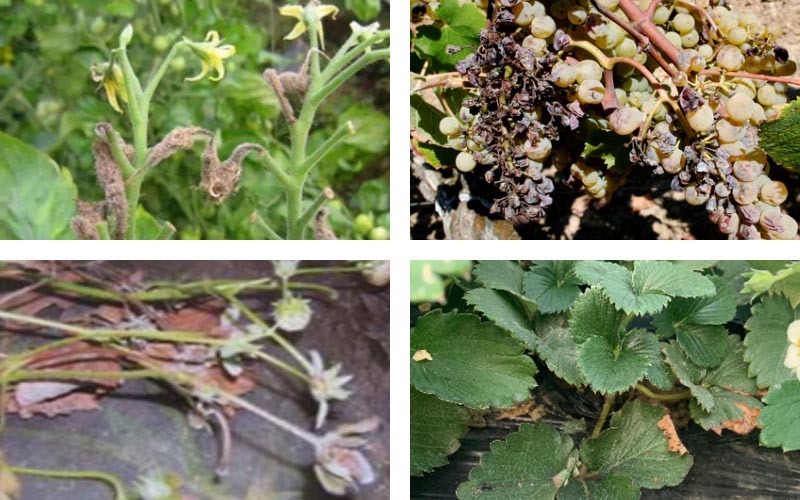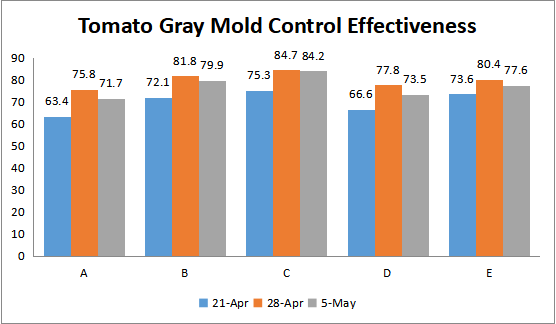Case Studies
We provide plant protection and plant nutrition products that help build healthy and sustainable food systems.
Disease Control in Tomato Gray Mold
Fungicide
Gray mold is a common fungal disease that affects most vegetables and fruit trees, including tomatoes, strawberries, and cucumbers. Caused by Botrytis cinerea, this pathogen not only infects stems, leaves, flowers, and fruits, affecting their quality and yield but also causes damage during transportation and storage. In severe cases, fruit and vegetable production can be lost entirely or reduced by 50%. Proper field management is crucial to prevent this disease. This includes ensuring proper plant spacing, promptly removing accumulated water, and quickly cleaning diseased leaves, branches, and fruits.

In addition to field management, gray mold can also be managed using fungicides. Sunjoy Agro recommends the use of Greyhunter (Pyraclostrobin 15% + Boscalid 30% SC) for foliar spray to prevent gray mold, powdery mildew, anthracnose, brown spot, and other diseases. Greyhunter has a good inhibitory effect on spore germination, germ tube elongation, appressorium formation, hyphal growth, and sporulation of the pathogen. Using it before fruit picking can prevent gray mold during storage, extend the shelf life, and ensure the taste of the fruit. Furthermore, it is beneficial to crop growth by enhancing crop tolerance to adverse environments and increasing crop yield.
Application Suggestions
|
Crop |
Disease |
Application rate |
|
Tomato |
Gray Mold, Powdery Mildew |
Foliar spray: dilute 1000-2000 times before planting, flowering, or after fruit picking. |
|
Strawberry |
Gray Mold |
Foliar spray: dilute 1000-1500 times at seedbed, flowering or young fruit stage. |
|
Cucumber |
Gray Mold, Powdery Mildew |
Foliar spray: dilute 1000-2000 times during the flowering and fruiting period. Spray 1-2 times depending on disease severity. |
|
Peach |
Brown Rot |
Foliar spray: dilute 1000-2000 times after flowering to fruit maturity. Spray 2-3 times depending on disease severity. |
Performance Results
1.1 Test purpose
The purpose of this study is to verify the control effect of Greyhunter on tomato gray mold.
1.2 Fungicide and Experiment
|
No. |
Fungicide |
Formulation dosage (g/ha) |
A.I. dosage (g/ha) |
|
A |
Pyraclostrobin 15% + Boscalid 30% SC |
375 |
168.75 |
|
B |
Pyraclostrobin 15% + Boscalid 30% SC |
450 |
202.5 |
|
C |
Pyraclostrobin 15% + Boscalid 30% SC |
525 |
236.25 |
|
D |
Pyraclostrobin 30% SC |
750 |
225 |
|
E |
Boscalid 50% WG |
600 |
300 |
1.3 Results

The fungicides were applied twice on 4/14 and 4/21 in 2017 to control the early gray mold in the flowering and fruit stage of the tomatoes. Control effectiveness was tested on 4/21, 4/28, and 5/5. Experimental data were analyzed using the DMRT method.
The test field was located in Ningbo City, Zhejiang Province. The test variety was the “Ju Wang 983” tomato.
1.4 Conclusion
According to the results of our experiment, Greyhunter (Pyraclostrobin 15% + Boscalid 30% SC) is more effective in controlling tomato gray mold compared to Pyraclostrobin 30% SC and Boscalid 50% WG. Our findings indicate that Greyhunter is safe for the tomato variety tested under the conditions of this experiment. The fungicide can be used to prevent and control tomato gray mold. Sunjoy Agro recommends using Greyhunter as a preventative and curative measure for tomato gray mold, especially during the early stages. It is recommended to spray the fungicide evenly on the plant leaves 2-3 times with an interval of 7-10 days. The recommended dosage of active ingredient is 168.75-236.25 g/ha, which is equivalent to the formulation dosage of 375-525 g/ha.
Previous
Explore More

